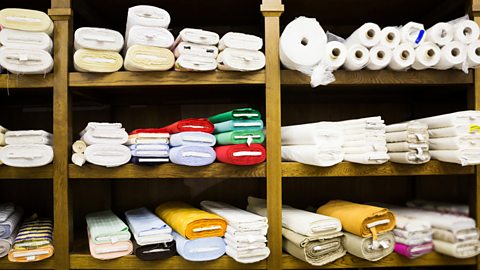Stock forms
Stock forms
Textiles are sold as different stock formStandard sizes for a material, component or product., depending on the standard sizes and thicknesses:
- rolls and bolts - fabric is sold by the metre in the roll (circular) or bolt (flat roll) and standard sizes are 90 cm (interfacings), 115 cm, 150 cm, 200 cm, 240 cm (for cotton sheeting)
- fat quarters - pre-cut fabrics for quiltingUsing a running stitch (by hand or machine) through two or more layers of fabric, one of which is wadding. The stitching, once sewn through the layers, creates a padded and decorative effect. projects are sold as bundles (46 cm ├Ч 56 cm), known as fat quarterA quilterтАЩs term and a popular way to purchase fabric for patchwork crafts. A fat quarter (measured originally from a yard) measures 46 cm x 56 cm., often made up of complementary colours and patterns
- denier - the unit of unit of weightThe measurement scale used for weight, eg grams or ounces. that measures fineness, used to describe the thickness of tights, where 30 denier is thin and 100 is thick, increasing commonly in increments of 10
- ply - yarnShort threads spun to form one long thread. (wool) is sold in coils, reels or balls, and ply is the number of threads spun together to create a yarn

Calculation sizes
When calculating the amount of fabric needed for a project, a seam allowance of 1.5 cm should always be taken into account.
Example
A double-sized duvet cover must measure 200 cm ├Ч 79 cm when sewn. How much fabric is needed to make it?
With a seam allowance of 1.5 cm either side:
200 + (1.5 ├Ч 2) = 203
79 + (1.5 ├Ч 2) = 82
Area:
203 ├Ч 82 = 16,646 cm2
For both sides of the cover:
16,646 ├Ч 2 = 33,292 cm2
Question
A quilt for a bed must measure 120 cm ├Ч 190 cm when sewn and will be made from patchwork squares of fabric. If each patchwork square measures 9.5 cm ├Ч 9.5 cm, how many pieces are needed to make the finished quilt?
Note: DonтАЩt forget to allow for the seam allowance of 1.5cm.
With a seam allowance of 1.5 cm either side:
9.5 + (1.5 ├Ч 2) = 12.5 cm
Area of each patchwork square:
12.5 ├Ч 12.5 = 156.25 cm2
Area of quilt:
120 ├Ч 190 = 22,800 cm2
22,800 cm2 ├╖ 156.25 cm2 = 145.92
146 fabric squares will be required to make a bed quilt measuring 120 cm ├Ч 190 cm.